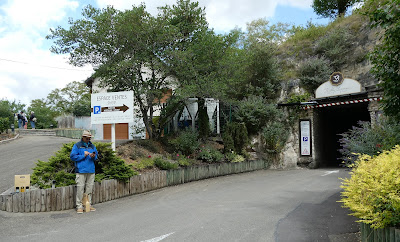Our current life in Auxerre could be described as both "settled" and "unsettled." We've quickly "settled" into living in Auxerre and not moving the boat from day-to-day; we've not even had to adjust our location on the quay. We've experienced no earth-shattering events, but we have been enjoying our slow perusal of the city's sites, the occasional movie and dining out, and using our bikes for a couple of exploratory trips outside of the city limits.
What's been "unsettled" has been the weather this past week--rain or the threat of rain most days, quite breezy, and temperatures more like early June than late July. (Not complaining about that, though, as we've no wish to experience the extreme heat that has enveloped southern Europe this year.) We have family coming for a few days this week and want to be able to take them out for a day cruise, but we're a little discouraged by the weather forecast for the next week, which looks like a continuation of the wet and windy pattern. What's also unsettled (although "not settled" is probably a better way of putting it) is the electrical problem on the boat. The electrician should be back from vacation next week, so hopefully we can get him on site sooner rather than later. But we also have the problem that the new batteries that were delivered to us last week were not what we had ordered, so the order mix-up has to be resolved.
Auxerre continues to please us. The tourist office's walking tour is rather extensive--Auxerre's historical center is, after all, the second largest protected area in Burgundy--so we spent parts of three days exploring different sections of the route (and still have more to do). One of the major stops was at the Saint-Germain Abbey, which currently houses the Art and History Museum. It is a former Benedictine monastery, founded in the 5th century and dedicated to its founder, the bishop of Auxerre, who died in 448.
 |
| The interior of the Abbey church. The present church was built in the 13th century. |
 |
| Most fascinating was the cellar that was accessed from the back of the church. It contains vestiges of earlier constructions on the church and . . . |
 |
| . . . sarcophagi dating from the 6th to the 9th centuries. |
 |
| Parts of the Abbey cloister date to the 12th century; this area in classical style was rebuilt in the 17th C. |
 |
| The abbey church houses a number of very old religious artifacts, including this 15th century stone figure of St. Denis. |
 |
| The Saint-Germain abbey church is visible above the Auxerre skyline, as is the adjacent 12th century tower of Saint Jean. |
The oldest part of the abbey is its 9th century Carolingian crypt, built around the tomb of Saint Germain. Access to the crypt is possible only with a guided tour, which we didn't have time for on the day we were there. It's definitely something that we'll be returning to the abbey to do.
 |
| The carved coat of arms on a 16th C. house, the scissors and comb denoting the location of a former barber and hairdresser shop. |
 |
| A statue honoring Charles Surugue, former mayor of Auxerre, who enlisted in the French army in 1915 at the age of 76. He was the oldest soldier in the Great War. |
 |
| There had been a double rainbow just before Lon snapped the photo; too bad he missed it. |
 |
| Auxerre old town center. |
 |
| This was probably one of the heaviest concentrations of timbered houses in town. |
 |
| Saint-Pierre Church. The 16th and 17th century church is on the site of a 6th century basilica (that became part of an 11th century monastery). |
 |
| The ceiling decorations in Saint-Pierre were stupendous. Not bad for a church whose parishioners were wine-growers and butchers. |
 |
| We always love our reunions with Suze, Rosa, Yolanda and Joost. |
Yesterday, Sunday, July 30, the weather finally allowed us to venture a bit further afield. We decided to visit a couple of places that we'd had to skip when we turned back to Auxerre to deal with the boat's electrical issues. To get to our first stop of the day we cycled south along the Nivernais Canal, nearly to where we'd overnighted on our shortened trip.
 |
| Thirty minutes by bike to get to this spot on the Nivernais-- when we did it by boat it took us nearly 4 hours. |
 |
 |
| Small baths and a latrine. |
 |
| From the Merovingian necropolis. |
 |
| They had quite a collection of sculpted stone blocks, and carvings from a 2nd century religious sanctuary. |
 |
| A mural found in the residential portion of the villa. |
 |
| Studio and gallery of artist Georges Hosotte, whose gallery in the Chapelle de Bailly I had visited previously. It wasn't open for visitors until later in the day. |
 |
| Irancy is known for pinot noir wine. There were several wine houses in the village. It reminded us of the villages we visited in the Champagne region. |
 |
| The Saint-Germain church (12th - 18th C.), was an unusual shape. No entry to be had for us, as Sunday services were taking place. |
 |
| Lon waits for me to finish taking pictures. |
 |
| What would a wine village be without the surrounding vineyards? |
 |
| By the time we stopped for lunch the sun had almost disappeared, and had we been sitting exposed to the breeze we would have been uncomfortable. It was definitely jacket weather. |





































